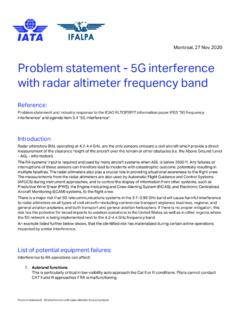Transcription of Introduction to Communication Systems
1 Introduction to Communication Systems James Flynn Sharlene Katz Communications System Diagram July 1, 2010 Flynn/Katz - SDR 2 Information Source and Input Transducer Transmitter Channel Receiver Output Transducer Communications System Diagram July 1, 2010 Flynn/Katz - SDR 3 Information Source and Input Transducer Transmitter Channel Receiver Output Transducer Information Source: Audio, image, text, data Input Transducer: Converts source to electric signal Microphone Camera Keyboard Communications System Diagram July 1, 2010 Flynn/Katz - SDR 4 Information Source and Input Transducer Transmitter Channel Receiver Output Transducer Output Transducer: Converts electric signal to useable form Speaker Monitor Communications System Diagram July 1, 2010 Flynn/Katz - SDR 5 Information Source and Input Transducer Transmitter Channel Receiver Output Transducer Transmitter: Converts electrical signal into form suitable for channel Modulator Amplifier Communications System Diagram July 1, 2010 Flynn/Katz - SDR 6 Information Source and Input Transducer Transmitter Channel Receiver Output Transducer Channel: Medium used to transfer signal from transmitter to receiver.
2 Point to point or Broadcast Wire lines Fiber optic cable Atmosphere Often adds noise / weakens & distorts signal Communications Channels July 1, 2010 Flynn/Katz - SDR 7 Wireline Twisted Pair Cable Waveguide Fiber Optics Wireless (radio): Transmission of electromagnetic waves from antenna to antenna KHz to ultraviolet Propagation characteristics vary with frequency Increasing bandwidth Propagation Characteristics of Radio Channels July 1, 2010 Flynn/Katz - SDR 8 Ground Wave Low MHz Waves guided between earth and ionosphere Distance of Communication varies based on wavelength AM Radio (1 MHz) propagates < 100 miles in day but longer at night Predictable propagation Sky Wave Low MHz 30 MHz Signals reflect from various layers of ionosphere Changes based on time, frequency, sun spots Signals travel around the world Less predicable propagation Propagation Characteristics of Radio Channels (cont d)
3 July 1, 2010 Flynn/Katz - SDR 9 Line of Sight Above 30 MHz Need little or no obstruction limited by horizon Noise issues In GHz range rain issues Used for Satellite and local communications Very predictable / stable propagation Other Channels Acoustic channels Table of Frequencies July 1, 2010 Flynn/Katz - SDR 10 ELF : 0 3 kHz. Submarine communications. VLF : 3 30 kHz. Submarine communications, Time Signals, Navigation LF : 30 300 kHz. Navigation, Time Signals. MF: 300 kHz 3 mHz. Maritime Voice/Data, AM Broadcasting, Aeronautical Communications. HF: 3 30 mHz. Shortwave Broadcasting. Amateur, Point to Point data. Maritime Voice/Data. Aeronautical Communications. VHF : 30 300 mHz. Police, Fire, Public Service mobile.
4 Amateur. Satellite. Analog TV. FM Broadcast. Chart of Frequencies (cont d) July 1, 2010 Flynn/Katz - SDR 11 UHF : 300 3,000 mHz (3 gHz) Police, Fire, Public Service communications. Satellite. Analog and HD TV. Telemetry (flight test). radar . Microwave links (telephone/data). WiFi. SHF : 3 30 ghz radar . Satellite. Telemetry. Microwave links EHF : 30 300 ghz radar . Satellite. Microwave links. Communications System Diagram July 1, 2010 Flynn/Katz - SDR 12 Information Source and Input Transducer Transmitter Channel Receiver Output Transducer Receiver Extracts an estimate of the original transducer output Demodulator Amplifier Why do we need Modulation/Demodulation? July 1, 2010 Flynn/Katz - SDR 13 Example: Radio transmission Microphone Voice Electric signal, 20 Hz 20 KHz Transmitter Antenna: Size requirement > 1/10 wavelength At 3 KHz: Antenna too large!
5 Use modulation to transfer information to a higher frequency =cf=3 1083 103=105=100km .1 =10kmWhy do we need Modulation/Demodulation? (cont d) July 1, 2010 Flynn/Katz - SDR 14 Frequency Assignment Reduction of noise/interference Multiplexing Bandwidth limitations of equipment Frequency characteristics of antennas Atmospheric/cable properties Types of Modulation July 1, 2010 Flynn/Katz - SDR 15 Analog Modulation: A higher frequency signal is generated by varying some characteristic of a high frequency signal (carrier) on a continuous basis AM, FM, DSB, SSB An infinite number of baseband signals ECE 460 Digital Modulation: Signals are converted to binary data, encoded, and translated to higher frequency FSK, PSK, QPSK, QAM More complex, but reduces the effect of noise Finite number of baseband signals ECE 561 Performance of a Radio Link To determine how well a link performs, we need to know: -Signal to noise ratio at receiver -Modulation scheme CAN YOU HEAR ME NOW?
6 July 1, 2010 16 Flynn/Katz - SDR Performance of a Radio Link In analog Systems , performance is subjective. In digital Systems , performance is precisely specified as Probability of Error, Pe. In digital Systems , Pe determined by modulation scheme and Signal to Noise Ratio, SNR. Pe=number of errors in n bitsnJuly 1, 2010 17 Flynn/Katz - SDR Performance of a Radio Link SNR at receiver crucial in determining link performance. May be expressed in dB. SNR=signal power at receivernoise power at receiverJuly 1, 2010 18 Flynn/Katz - SDR Performance of a Radio Link Signal Power at Receiver determined by LINK EQUATION Also known as the Friis Equation Used to compute power levels at receiver based on distance, transmitter power and antenna gain.
7 Used only for free-space, line of sight links. Ground wave and ionospheric reflection are not covered. UHF freqencies (300-3000 mHz) are line of sight. July 1, 2010 19 Flynn/Katz - SDR Performance of a Radio Link The transmitter side: Assume an isotropic radiator. Radiates power equally in all directions. Does not exist in reality. A mathematical construct to compare other antennas to. Assume all of the transmitter power goes into space. July 1, 2010 20 Flynn/Katz - SDR Performance of a Radio Link Between transmitter and receiver: Signal expands in all directions. At some distance, d, signal covers a sphere with surface area: Power density, Ps: S=4 d2 PS=PtS=Pt4 d2 July 1, 2010 21 Flynn/Katz - SDR Performance of a Radio Link d July 1, 2010 22 Flynn/Katz - SDR Performance of a Radio Link At the receiver: Aperture : How much of the signal sphere is captured by the receiver antenna.
8 For isotropic antenna, aperture is expressed as an area: A= 24 July 1, 2010 23 Flynn/Katz - SDR Performance of a Radio Link d AJuly 1, 2010 24 Flynn/Katz - SDR Performance of a Radio Link Signal power at the receiver: Basic Link equation with isotropic antennas. Pr=APS=Pt 24 d()2 July 1, 2010 25 Flynn/Katz - SDR Performance of a Radio Link Antenna Gain Antenna is a passive device cannot add power and may have losses. Gain is power increased in one direction at the expense of it in another. July 1, 2010 26 Flynn/Katz - SDR Performance of a Radio Link Antenna gain: same power over smaller area. Power density increased. Reciprocity means transmitting gain is also receive gain for same antenna. Common gains: 2 to 30 db over isotropic.
9 D ATRANSMITTER ANTENNA RECEIVER ANTENNA July 1, 2010 27 Flynn/Katz - SDR Performance of a Radio Link Link equation with antenna gains: Tradeoffs: Higher frequency = lower receive power But easier to build high gain antennas at higher frequency Also lower noise at higher frequency Pr=PtGtGr 24 d()2 July 1, 2010 28 Flynn/Katz - SDR Performance of a Radio Link Noise Sources: Terrestrial, mostly lightning. (HF) Extra-terrestrial, mostly the sun.(VHF through microwaves) Man-made. (possible at all frequencies, but usually low frequency) Thermal (all frequencies) Quantizing (only in digital signal processing) Circuit July 1, 2010 29 Flynn/Katz - SDR Performance of a Radio Link Thermal or Johnson noise. Dependent on: Absolute Temperature, T (Kelvin) Bandwidth, B (Hz) Pn=4kTBk= 10 23 joules/ KJuly 1, 2010 30 Flynn/Katz - SDR Performance of a Radio Link Circuit Noise From active devices: transistors and FETs Can be slightly above thermal noise power to many times thermal noise power.
10 Careful design can minimize circuit noise. July 1, 2010 31 Flynn/Katz - SDR Performance of a Radio Link Quantizing noise Produced by A to D conversion. Proportional to minimum digital level. Also dependant on modulation scheme. Example: signal is almost exactly between levels 1002 and 1003. Tiny change in voltage leads to full step. Effectively adding/subtracting about bit level. July 1, 2010 32 Flynn/Katz - SDR Performance of a Radio Link How much SNR is enough? July 1, 2010 33 Flynn/Katz - SDR Performance of a Radio Link Comparison of various simple digital Systems : Pe,OOK=12erfcSNR22 Pe,FSK=12erfcSNR2 Pe,PSK=12erfcSNR2 July 1, 2010 34 Flynn/Katz - SDR Performance of a Radio Link Designing a System Example F = 400 mHz.
















